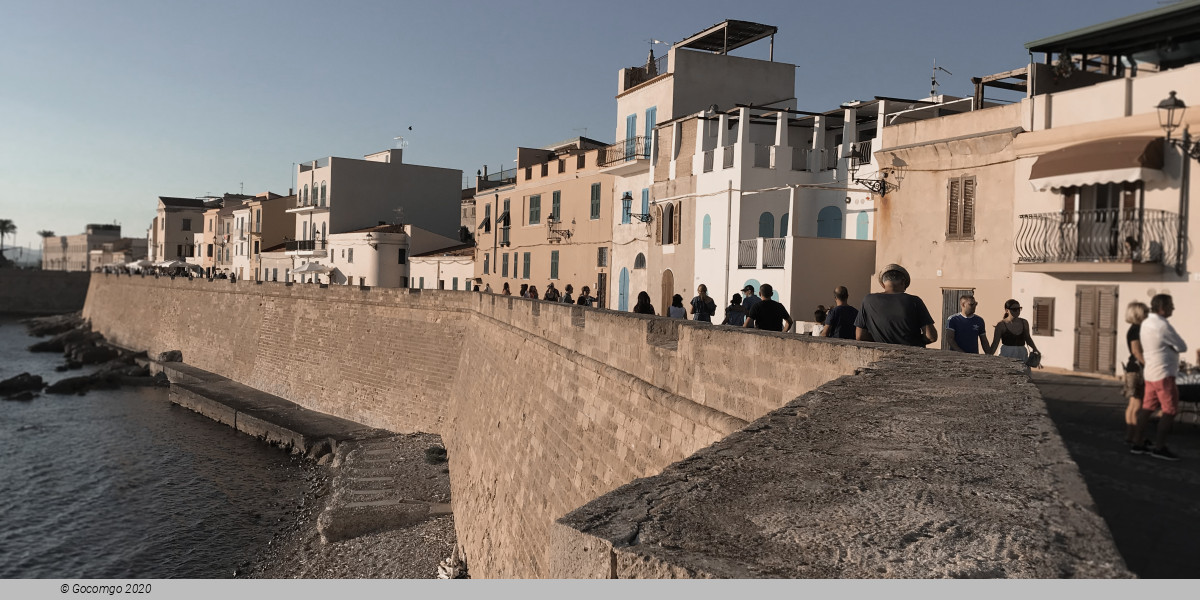Alghero

Alghero, also known in the local Algherese dialect as L'Alguer is a town of about 45,000 inhabitants in the Italian insular province of Sassari in northwestern Sardinia, next to the Mediterranean Sea. Part of its population descends from Catalan conquerors from the end of the Middle Ages, when Sardinia was part of the Crown of Aragon. Hence, the Catalan language is co-official (a unique situation in Italy) and known as the Alguerès dialect. The name Alghero comes from Aleguerium, which is a mediaeval Latin word meaning "stagnation of algae" (Posidonia oceanica).
History
The Phoenicians arrived by the 8th century BC and the metalworking town of Sant'Imbenia – in the area of later Alghero –, with a mixed Phoenician and Nuragic population, engaged in trade with the Etruscans on the Italian mainland.The area of today's Alghero has been settled since pre-historic times. The Ozieri culture was present here in the 4th millennium BC (Necropolis of Anghelu Ruju), while the Nuraghe civilization settled in the area around 1,500 BC.
Due to its strategic position on the Mediterranean Sea, Alghero had been developed into a fortified port town by 1102, built by the Genoese Doria family. The Dorias ruled Alghero for centuries, apart from a brief period under the rule of Pisa between 1283 and 1284. Alghero's population later grew because of the arrival of Catalan colonists. In the early 16th century Alghero received papal recognition as a bishopric and the status of King's City (ciutat de l'Alguer) and developed economically.
Historically, the city was founded in the early twelfth century between 1102 and 1112, when the noble Doria family of Genoa was allowed to build the first historical nucleus into an empty section of the coast of the parish of Nulauro in Judicature of Torres (Sassari). For two centuries it remained in the orbit of the Maritime Republics, first and foremost the Genoese, apart from 1283–1284 when the Pisans were able to control it for a year. It is plausible that at this time the town shared, given its commercial and multi-ethnic nature, a language similar to the nascent Sassarese.
The village was conquered by force by the Crown of Aragon, at the behest of King Pere IV of Aragon (r. 1336–1387), who later actively promoted colonisation of the town and the surrounding area, sending numerous families from different counties and provinces of the then Crown of Aragon, including Valencia, Majorca, Catalonia and Aragon. These were granted enticing privileges, and in fact, replaced the original population some of whom were sent to the Iberian Peninsula and Majorca as slaves. The dialects these families spoke in Alghero, were all very similar and derived from the same linguistic family. Over time it settled on its current form of Catalan, despite the subsequent decline of the Crown of Aragon.
The Aragonese were followed by the Spanish Habsburgs, who ruled until 1702 and continued expanding the town.
In 1720 Alghero, along with the rest of Sardinia, was handed over to the Piedmont-based House of Savoy, upon the arrival of which a policy of Italianization was commenced. In 1821, a famine led to a revolt by the population, which was bloodily suppressed. At the end of the same century, Alghero was de-militarised.
During the Fascist era, part of the surrounding marshes were reclaimed and the suburbs of Fertilia and S.M. La Palma were founded. During World War II (1943), Alghero was bombed, and its historical centre suffered heavy damage. The presence of malaria in the countryside was finally overcome in the 1950s.
Since then, Alghero has become a popular tourist resort.

